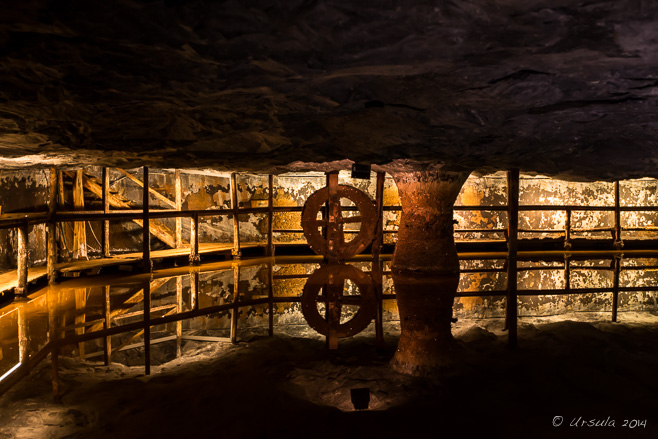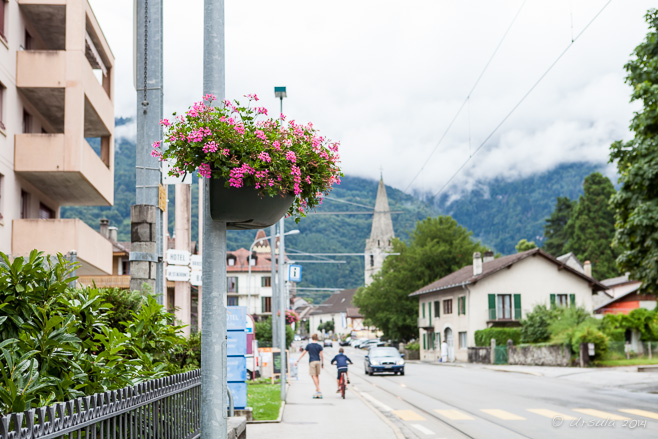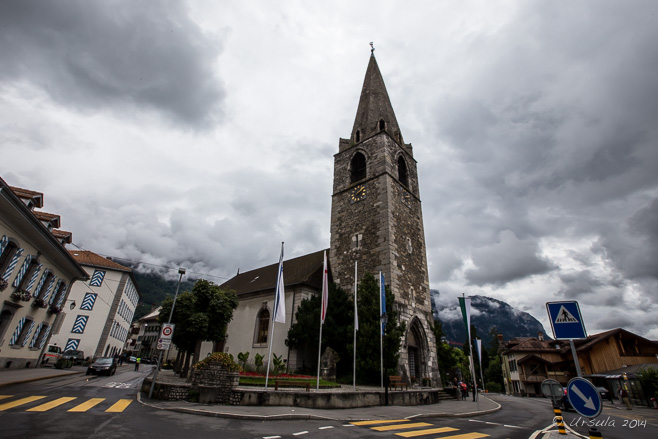
The Marie-Louise Reservoir
There is a natural beauty in this old reservoir, dug out of the Bex countryside by hammer and chisel in the 1800s.
Salt.
“Worth ones salt.” To be of value; worth ones pay. The English word “salary” comes from the Latin salarium (where sal is Latin for salt), thought to have been the allowance given to Roman soldiers to buy salt.
Since time immemorial, salt – sodium chloride (NaCl) – has been recognised for its critical importance to the life of humans and animals alike. Before the invention of canning and refrigeration, salting food was the principle means of preserving it.
“You [good Christians] are the salt of the earth”, Matthew (5:13) attributes to Jesus, where salt is a preserver, an enhancer – necessary to a healthy life.
So, in the days before a salt shaker on every table, where did people acquire this essential commodity?
In coastal areas, salt can be mass-produced by evaporation of seawater or brine from brine wells and salt lakes (see: Salt! Samut Sakhon, Thailand).
In regions away from the sea, it has to be imported, or mined – which, prior to the Industrial Revolution, was a difficult and dangerous task, often performed by slaves or prisoners. Hence, the expression: “back to the salt mines” for the return to an arduous or unpleasant job.
Why my preoccupation with salt?
Well, we were in the Swiss Alps this summer and meant to be walking among the peaks and meadows… But it rained. And rained. We were staying in a tiny village that didn’t offer a lot of bad-weather recreation, so – on the advice of a local – we hopped on a couple of trains and took ourselves to the nearby municipality of Bex for a tour of the Bex Salt Mines. That way, our informant told us, we’d be out of the wet!
Switzerland is, of course, land-locked. Before the discovery of salt deposits near Bex in the 15th century, the precious substance had to be transported from foreign suppliers over the mountains at great expense. The finding of the salt springs is attributed to a local shepherd, but it was the Bernese invaders to the region who, in 1475, started boiling the water from these slightly saline springs, rendering the salt through evaporation.
Excavation of the springs began in ernest in 1684. Over time, periodic digs resulted in the vast maze of passages, shafts, stairs and gigantic caverns, extending almost 50 kilometres, under the villages of Villars, Chesières and Arveyes, that exists today. The mine still operates, producing salt and salt-based products as well as generating electricity. It also operates as a historical tourist facility and a function centre.
After we arrived at the Bex Railway Station, I tested my French and procured two coffees and a map. The skies cleared sufficiently, so with our raincoats and umbrellas, we set off through the town and along the cross-country walking trails to the Salt Mines.

Central Street in Bex
A typical small Swiss town view: hanging flower baskets, a church spire, and quaint roofs – and mountains as a backdrop.

Le Temple de Bex
Built on the site of a 12th century Catholic church dedicated to St. Clément I, the Protestant church that now commands the centre of town was started in the 16th century – after the Reformation.

House on le Grand Eau
The land was green and wet as we walked along the Avançon River.

Sculpture Garden
As we continued into the hills, we came across an unmarked garden, dotted with sculptures.

Into the Woods
Soon we were off the roads and onto the pathways. The chip-bark underfoot was lovely – especially given the wet weather, and some of the very steep inclines.

Chemin Randonnée Pedéstre
Coming across signposting is always encouraging, especially as the walk was much longer than we were led to believe: 8 kilometres rather than 5-6, and rather hilly.

Vous êtes le sel de la terre – Matthieu, V-13-16
Ainsi soit-il et respectons la peine d’autrui, les cultures, la vigne et le dur ouvrage de nos ancêtres.
You are the salt of the earth – Matthew, 5:13-16
So be it and respect the worth of others, crops, vines and hard work of our ancestors.

Cow in the Vines
The low-toned chimes of cow bells greeted us as we commenced a long traverse across the vineyards after coming out of the woods.

Vinyards
As we walked around the hill, we had views over the valleys and villages of Vaud.

Mine Entry
Finally! We came out of the vines, through more woods and down into the Bex Salt Mine, in time to pick up the tickets we had booked by phone, and wait for our guide. Tours frequently sell out – especially in wet weather.

Reservoir Rond
After we take our seats in The Round Reservoir we are shown a 15 minute video about the history of the mine – in French with difficult-to-read subtitles in German, Italian and English.

Reservoir Marie-Louise
The second chamber we entered was the beautiful Marie-Louise Reservoir. The giant 1,500 cubic meter cavern, supported by columns, was named for Empress Marie Louise of France, Napoleon’s second wife. She visited the site in 1814 after Napoleon was already in exile.

Looking Down the Shaft
Started in 1743, the digging-out of the 215 meter-deep Bouillet Shaft took 26 years of manual labour using only hammers and chisels.

The Train
We all climb into small train carriages at the Gare de Puits and the trains take us 1500 meters to the heart of the mine.

Tunnels
When we alight the train, more tunnels lead through the mine…

Trolley
… past anhydrite (dehydrated gypsum) walls and old utensils.

The Wine Cellar
The temperature in the Salle René Burnier is a stable 17° C all year round, making it a perfect place for the local vintners to store the fruits of the local harvest – under lock and key, of course.

Stairs
More stairs wind down to the Salle des Gradins…

Salle des Gradins
… where our guide explains the workings of the modern drill systems.

Salle du Talon
Old lamps, with examples from the 15th …

The Museum
… to the 20th C, hang on display.

Miner’s Locker
The Salle du Talon includes an authentic miner’s locker room. In the next rooms, the Puits de la Tranchée, examples of the tools used by the various craftsmen involved in salt extraction and production are laid out on show.

Salt
There are various displays, artworks, exhibits, and interactive activities for the children.

Train
The tour lasts two hours, but it doesn’t seem that long. Soon it is time to get back into the train carriages and return to the surface.

Into the Storm
Laden with fragrant salts we had purchased from the crowded shop, we walked back to the train station via the roadways, saving time and distance – making it back just before the skies opened once more.
 It was an enjoyable and educational experience – one I’d highly recommend.
It was an enjoyable and educational experience – one I’d highly recommend.
It certainly beat walking in the alps in the rain!
‘Till next time,
Happy Travels!
Pictures: 21July2014






























.png)


interesting photos of the sel mine. I have heared that in Polen a very great and beautiful sel mine is. Greetings Dietmut
Hi Dietmut,
Thanks for your visit. It was a fascinating and beautiful place.
Cheers, Ursula